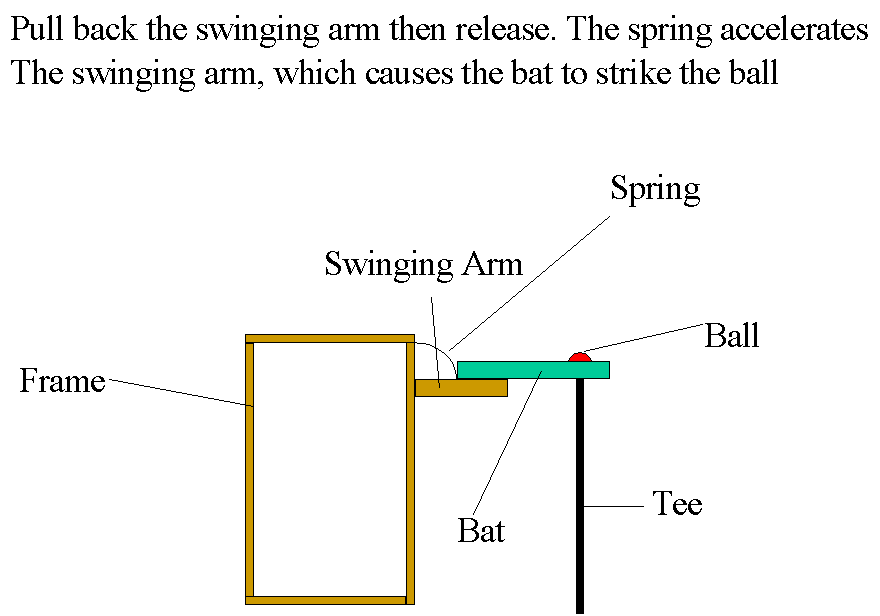Exploration into the Mechanics of a Baseball bat
By Brad Christopherson and Sam Preston
Table of Contents
| Making our "Swinging Machine" | |
| Materials | |
| Procedure | |
| Diagram | |
| Findings | |
| Analysis | |
| Conclusion | |
| Links | |
| Return to Research |

1. Create a square frame from two-by-fours and nails
2. Attach another two-by-four to the frame with a door hinge (this will be the swinging arm)
3. Attach a clamp to the end of the swinging arm
4. Secure the handle of the bat to the clamp
5. Connect the frame to the arm with a spring. Connect so the spring is tight when the arm is pulled back
1. Our swinging machine
2. Stakes
3. 10 baseballs
4. Measuring tape
5. baseball tee or similar device
1. Nail stakes to swinging machine
2. Pound machine into ground
3. Place tee in desired position
4. Place ball on tee
5. Pull bat back and let swing
6. Repeat steps 4-5 ten times
7. Measure total distance of balls
8. Move tee to one of the five positions
9. Repeat steps 4-8 until all 50 data points are collected

All distances are measured in feet.
Link to text file (Text - tab delimited)


By doing our experiment we found out that different spots on the bat do indeed result in different hitting distances. We found that the spot two inches above the thickest part of the bat actually produced a slightly farther hitting distance than the thickest part of the bat. As our graph indicates, hitting distances starts low at the handle of the bat, then it increases until it reaches two inches past the thickest part of the bat. After that, the distances decrease due to the dimple at the end of the bat, which gives the ball less pop. We initially assumed the "sweet spot" on the bat was at the thickest part of the bat. We thought that this was because the thickest part of the bat had the most stability, and the ball would pop off it more quickly; however, we found out that if we hit the ball slightly farther down the bat, the bat has more velocity and actually produces slightly farther hitting distances.
Our hypothesis was marginally incorrect. The sweet spot did indeed produce farther hitting distances, but not 2-3 times as we expected. The distances at the sweet spot at an average of 47.67 feet were only about 30% farther than some of our lowest distances around 33 feet which were hit a few inches from the handle. This is significant and shows that all baseball players should strive to hit it on the sweet spot of the bat to achieve maximum hitting distance.
Our machine was meant to replicate the swing of a baseball player, and to be consistent for accurate results. However, there are a few differences between our machine and a real swing that affect the results of our data and the actual results for baseball players. For one, the ball was stationary unlike a real pitch, which would have velocity and would add force to the ball. We are not sure if this would have affected the results of our experiment, but it may have. Also, because of our limited resources, we could not build the most efficient machine for swinging a bat. It was made out of two-by-fours, a few nails and a spring. We cannot guarantee that the bat speed was consistent for every swing. also for the same reasons, we cannot guarantee that the ball was hit on the same vertical position of the bat, which could also affect our results. to improve our experiment, we could have done our testing on a flatter surface, to get rid of inconsistencies caused by bouncing on un-even ground.
http://www.pcmag.com/encyclopedia_term/0,2542,t=sweet+spot&i=52302,00.asp - Basically just defines what a sweet spot is.
http://www.physics.usyd.edu.au/~cross/baseball.html - This is a good site that explains how the vibrations in a baseball bat work.
http://www.exploratorium.edu/baseball/sweetspot.html - This site is a good help in finding the sweet spot on a bat.
http://www.batspeed.com/mechanics.html - This site is helpful in understanding what forces are active in hitting a baseball.
http://www.kettering.edu/~drussell/bats-new/sweetspot.html - This site helps explain why the sweet spot on a bat is so sweet.